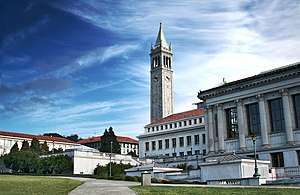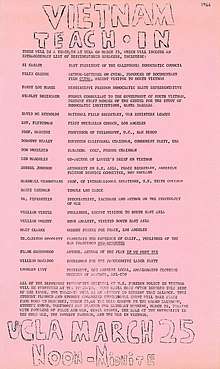Vietnam Day Committee
The Vietnam Day Committee (VDC) was a coalition of left-wing political groups, student groups, labour organizations, and pacifist religions in the United States of America that opposed the Vietnam War during the counterculture era. It was formed in Berkeley, California in the spring of 1965 by activist Jerry Rubin, and was active through the majority of the Vietnam war, organizing several rallies and marches in California as well as coordinating and sponsoring nationwide protests.
Activities

The VDC was formed by Jerry Rubin and Stephen Smale between May 21 and May 22, 1965 during a 35‑hour‑long anti-Vietnam war protest that took place inside and around the University of California, Berkeley, and attracted over 35,000 people including Paul Montauk and Stew Albert. The VDC laid out three main objectives: to achieve national and international solidarity and coordination on action, to take part in militant action, including civil disobedience and to work extensively in the community to develop the movement outside of the university campus.[1] Attending the event were several notable anti-war activists, including Dr. Benjamin Spock, however the State Department declined to send a representative, despite the burning of an effigy of president Lyndon Johnson.
On May 5, 1965, the VDC were involved in a march of several hundred students from Berkeley on to the Berkeley Draft Board, where staff were given a black coffin as a gift, and a number of students set alight their draft cards.
Later that year, the VDC planned a nationwide protest known as the International Days of Protest Against American Military Intervention, which was scheduled to take place between October 15 and October 16. In arranging and coordinating the protest movement, the VDC headquarters in Berkeley communicated with numerous anti-war groups in New York City, Boston, New Haven, Philadelphia, Pittsburgh, Detroit, Ann Arbor, Chicago, Madison, Milwaukee, Minneapolis, Los Angeles, Portland and Atlanta.[1] The planned movement attracted attention from some newspapers like the National Guardian:
Preparations are being made in about two dozen American cities for coordinated mass protests Oct. 15-16 in opposition to U.S. aggression in Vietnam. Advance information indicates that demonstrations may surpass previous anti-war protests not only in total numbers and intensity of action, but in long-range benefit to the peace movement, for the emphasis of the "national days of protest" is on community organization and education as well as on direct action against the war.[2]
Similar groups began to form outside of California, notably in Mexico City and Tokyo. In California, what was now known as the International Days of Protest was to culminate with a peace march towards the Oakland Army Terminal, where men and materials were sent to Vietnam. On October 15, 1965, the protests took place across the country, with the VDC itself organising a sit-in at the San Francisco State College, which saw a performance by Country Joe and the Fish.
The VDC organised another peace march which took place on November 21, 1965, and saw over 10,000 people marching through Oakland.[3] The march was the first of its kind in California, and was one of many orchestrated by the VDC from 1965 through until 1972, illustrated partly by the number of pro-war protesters who lined the route holding signs that stated "Stamp out VDC".[4]
By this time, the activities of the VDC had attracted the interest of the California Senate Factfinding Subcommittee on Un-American Activities.

On March 25, 1966, the UCLA VDC, a group not organizationally tied to the Berkeley VDC, sponsored a well-attended, 12-hour 'teach-in' at UCLA.[5] This clashed with a small rally that supported America's involvement in Vietnam. The antiwar event had a number of guest speakers, including Simon Casady, a former president of the California Democratic Council, Dorothy Healy, the Southern California chairman of the Communist Party USA, and the British philosopher Bertrand Russell.
Notes
- Online Archive of California Vietnam Day Committee retrieved on April 5, 2007
- National Guardian September 4, 1965
- Oakland Museum Picture this article, retrieved on April 5, 2007
- Ilka Hartmann photograph retrieved on April 5, 2007
- "UCLA Vietnam Day Committee planning and promotional documents for 25 March 1966 antiwar teach-in".